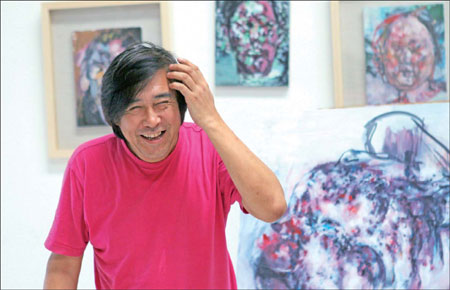Artistic footsteps
Updated: 2012-08-17 11:13
By Chen Nan (China Daily)
|
|||||||||||
|
Chinese artist Lin Mo finds himself back in China after spending 18 years in Spain. Zou Hong / China Daily |
Life sometimes surprises. Artist Lin Mo shares his expereinces in Spain
The Spanish city of Barcelona is known for much more than its popular football team. It has many beautiful buildings, works of art, specialty shops and restaurants. Yet, for Chinese artist Lin Mo, 50, who spent 18 years in Barcelona, the city brings back memories of emptiness in his heart. "I felt lost in the city. I didn't have friends to talk to and no one appreciated my art," he says during an interview at his studio in Songzhuang village, an art community located in east of Beijing. "I didn't want to imitate Western artists' works, and no one there seems to appreciate traditional Chinese ink painting."
Lin shared his book, Go Far to Find the Way Back - Lin Mo's Searching Journey in Spain, and his art works with audiences at Ullens Center for Contemporary Art on Aug 12.
Lin left Beijing to study art at University of Barcelona in 1990 with a scholarship awarded by Embassy of Spain in China. He knew nothing about the city nor spoke the language.
Arriving at the city with $1,000 (814 euros) and two dictionaries - Spanish to Chinese and Chinese to Spanish - he went with his eyes open to experience a whole new world. But what he experienced there was beyond his expectations.
As the first generation of Chinese contemporary artists who studied traditional Chinese ink painting since he was a child, Lin graduated from Luxun Academy of Fine Arts, one of northern China's top fine arts colleges, in 1986.
In Barcelona, Lin was overwhelmed by the art culture there - the way they paint and the logic of interpreting art were totally different from China. But Lin didn't want to return to China. He was curious about how the foreign land would shape his future and he was also hungry to be recognized.
In the midst of finding himself in the new artistic world, Lin, who was only 28 at that time, lost his wallet one day because of his carelessness. He was only left with a few coins.
"I felt like a victim, laden with one disaster after another. My heart was cold with emptiness," he shares.
With the few coins, he bought a lottery ticket. "I told myself, if I didn't win any money, I will jump into the sea," Lin recalls.
His life was not meant to end yet - the next day, he got a call from the bank that he won the first prize worth $400,000. "It was like an unbelievable dream," he says. He could have packed up and left but the first thing that crossed his mind was to continue trying to adjust to life in the new art world.
He invested part of the money to buy an abandoned castle near Sitges, a Spanish town about 35 kilometers southwest of Barcelona, and converted it into his art studio. Built in the end of the 17th century, the 1,000-square-meter castle is spread over four storeys with 17 rooms.
He recalls feeling empty again when he opened the windows of his new home, which faces the Mediterranean Sea - this time, not because he was helpless but because of the serenity of the surroundings.
"I spent days and nights painting in the studio. But when I stared out at the Mediterranean Sea, what I had painted felt meaningless," he says.
At about the same time, Lin was gradually stepping away from traditional Chinese ink painting and was exploring with oil painting. "I also experimented with combining the two painting styles - one, a realism expression and the other, abstract," he explains.
When he was not painting, Lin visited architecture designed by Antoni Gaudi and Barcelona's Picasso Museum, to be inspired by two of the greatest Catalonian artists. He got quite popular in Sitges and was selected as one of the candidates to vie for the position of mayor.
"My life in Spain then was still lonely, even though I knew many interesting people and saw many historical sites. I couldn't find myself and my artistic language," he says.
When Barcelona hosted the 1992 Summer Olympics, Lin opened a Chinese restaurant in the city, named Jiu, which means nine in Chinese and sounds the same as the Chinese word for everlasting. At about the same time, Lin met his wife, a Beijing tourist who was visiting Barcelona. They fell in love at first sight and got married in Barcelona.
By then, Lin had held several solo exhibitions in Spain and some other European countries. He took a break and stopped painting for several years, and only resumed when he returned to his hometown in 2000.
In 2005, he sold his castle and restaurant, and returned to Beijing as an independent artist. In 2011, he was one of the painters and art director of 2011 Louvre Contemporary Chinese Painting Exhibition. "Eighteen years ago, I went to Europe to look for the answer to contemporary art. But now I realize that what I truly want to find is right here, at home," he says.
chennan@chinadaily.com.cn
(China Daily 08/17/2012 page24)
Today's Top News
Rescuers race against time for quake victims
Telecom workers restore links
Coal mine blast kills 18 in Jilin
Intl scholarship puts China on the map
More bird flu patients discharged
Gold loses sheen, but still a safe bet
US 'turns blind eye to human rights'
Telecom workers restore links
Hot Topics
Lunar probe , China growth forecasts, Emission rules get tougher, China seen through 'colored lens', International board,
Editor's Picks

|

|

|

|

|

|






